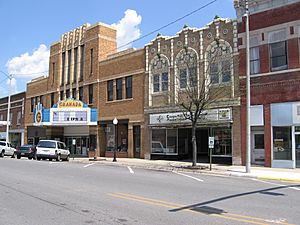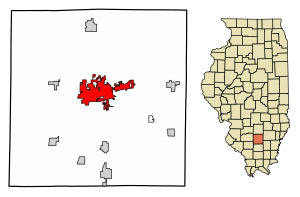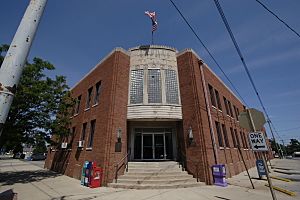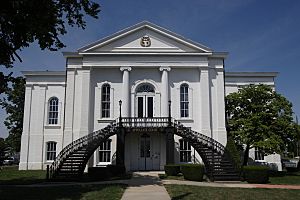Mount Vernon, Illinois facts for kids
Quick facts for kids
Mount Vernon, Illinois
|
|
|---|---|

Town Center of Mount Vernon
|
|
| Nickname(s):
The King City, The Festival City
|
|
| Motto(s):
Mount Vernon, City of Opportunity
|
|

Location of Mount Vernon in Jefferson County, Illinois.
|
|
| Country | United States |
| State | Illinois |
| County | Jefferson |
| Townships | Mount Vernon, Shiloh, Dodds, McClellan |
| Founded | 1817 |
| Area | |
| • Total | 14.66 sq mi (37.97 km2) |
| • Land | 14.58 sq mi (37.77 km2) |
| • Water | 0.08 sq mi (0.21 km2) |
| Elevation | 518 ft (158 m) |
| Population
(2020)
|
|
| • Total | 14,600 |
| • Density | 1,001.17/sq mi (386.56/km2) |
| Time zone | UTC−6 (CST) |
| • Summer (DST) | UTC−5 (CDT) |
| ZIP Code(s) |
62864
|
| Area codes | 618 |
| FIPS code | 17-51180 |
| GNIS feature ID | 2395129 |
| Public Transit | South Central Transit |
Mount Vernon is a city in Illinois, United States. It is the main city of Jefferson County. In 2020, about 14,600 people lived there. Mount Vernon is also the biggest city in the Mount Vernon Micropolitan Statistical Area. This area includes all of Jefferson and Hamilton counties.
| Top - 0-9 A B C D E F G H I J K L M N O P Q R S T U V W X Y Z |
History of Mount Vernon
Early Days: 1800s
Mount Vernon was started in 1817 by Zadok Casey. He was an important person in Illinois politics. He served in the State Senate and later in the U.S. Congress. The town got its name from George Washington's famous home, Mount Vernon. That home was named after a British naval hero, Edward Vernon.
When Mount Vernon was first founded, it was hard to reach. There were no good roads. Travelers had to find high ground or cross swamps. An important road called the Goshen Road passed nearby. But it didn't go through Mount Vernon.
To help the town grow, people built a bridge over Casey Creek in 1820–1821. They also built a new road towards Vandalia, which was the state capital. This new road made Mount Vernon an important stop for travelers.
In 1836, the Grant family moved to Mount Vernon. Angus McNeil Grant became very important to the town's growth. He helped develop the area.
In 1848, the Illinois Supreme Court moved one of its main offices to Mount Vernon. This meant important lawyers, including Abraham Lincoln, came to town. They would gather at the Mount Vernon Inn to discuss their cases. This historic inn is still recognized today.
In the 1870s, Mount Vernon tried to stop the sale of alcohol. A nearby village was created to allow it. But later, Mount Vernon allowed alcohol sales again.
On February 19, 1888, a powerful tornado hit Mount Vernon. It was half a mile wide. The tornado killed 37 people and destroyed over 450 homes. The Jefferson County Courthouse was also ruined. The American Red Cross helped the town recover. Clara Barton, who founded the Red Cross, led the relief efforts herself.
After the tornado, the Mount Vernon Car Manufacturing Company opened in 1889. This company built railroad cars. It grew quickly, making many cars each day. It employed over 1,000 workers by 1909.
Modern Times: 1900s and 2000s
During World War II, the "Car Shops" helped the war effort. They made things like bomb casings. Later, a company called National Railway Equipment Company took over part of the plant. Today, this company rebuilds and fixes diesel electric locomotives. They work for train lines all over the world.
In 1954, the original car shops closed. This caused many people in the city to lose their jobs for a while.
The Interstate Highway System was built in the 1950s and 1960s. Major highways like I-57 and I-64 now run near Mount Vernon. These highways made travel much faster and easier.
In April 2007, Mount Vernon elected its first female mayor, Mary Jane Chesley. She started her term on May 7, 2007.
Geography and Climate
Where is Mount Vernon?
Mount Vernon is about 13 square miles (34 square kilometers) in size. Most of it is land, with a small amount of water. The city is located about 65 miles (105 kilometers) east of St. Louis, Missouri.
The city sits on high ground. It is between Casey Creek and the Big Muddy River. These two waterways meet south of the town in Rend Lake. In the past, the area around these waterways was often swampy. This meant Mount Vernon was surrounded by water on three sides.
You can see Mount Vernon from high points to its west and east. From these spots, the town looks like a forested area sticking out into the lower lands.
Weather in Mount Vernon
Mount Vernon has a climate with warm summers and cold winters.
- The hottest month is usually July, with average high temperatures around 85.7°F (29.8°C).
- The coldest month is January, with average low temperatures around 21.7°F (-5.7°C).
- The city gets about 45 inches (114 cm) of rain each year.
- It also gets about 10 inches (25 cm) of snow each year.
People of Mount Vernon
In 2020, Mount Vernon had a population of 14,600 people. Most residents are White (80.6%) or African American (14.7%). About 2.4% of the population is Hispanic or Latino.
The average age in the city is 38.3 years old. About 24.3% of the people are under 18. About 18% are 65 or older.
The average income for a household in Mount Vernon was about $32,549. For families, it was about $36,660. Some families and people in the city live below the poverty line.
Many jobs in Mount Vernon are in healthcare and social services. Restaurants and food services also employ many people.
Economy and Jobs
Mount Vernon is home to a large Continental Tire factory. This factory covers 48 acres (19 hectares). The city also has big distribution centers for companies like NAPA and National Railway Equipment Company (NREC). Many other smaller businesses are located in the city's industrial parks. There are plans to create a new industrial park for even more distribution centers.
New development areas have been created to help businesses grow. For example, Pepsi built a new service and distribution center in 2011.
Main Employers in Mount Vernon
Here are some of the biggest employers in Mount Vernon as of 2023:
| Employer | # of Employees |
|---|---|
| Continental Tires the Americas | 3,496 |
| Walgreens Distribution Center | 2,138 |
| Good Samaritan Hospital | 1,484 |
| National Railway Equipment Company | 376 |
| Crossroads Community Hospital | 290 |
| Mount Vernon City Schools, District 80 | 283 |
| Rend Lake College | 261 |
| Spero Family Services | 197 |
| Jefferson County (government) | 178 |
| Mt. Vernon Township High School | 171 |
Arts and Fun Activities
Mount Vernon has a lot to offer for arts and culture:
- Cedarhurst Center for the Arts: This is a large art center with 90 acres of land. It offers art programs and performances all year. The Cedarhurst Craft Fair is held here every September. The Mitchell Museum is also on the Cedarhurst grounds.
- Market Days: On the first Saturday of each month from April to October, there's an outdoor market downtown. It's like a craft fair or flea market.
- Jefferson County Historical Museum and Village: This museum shows what life was like in Jefferson County from the mid-1800s to more recent times.
- C.E. Brehm Memorial Public Library: Built in 1905, this library is a great source of information downtown.
Did you know? In 1963, Beatles guitarist George Harrison bought a guitar from a music store in Mount Vernon! He was visiting his sister nearby. That guitar was later sold at an auction for $657,000 in 2014.
Parks and Outdoor Fun
Mount Vernon has several community parks with different features.
- Wayne Fitzgerrell State Recreation Area: This park is located south of Mount Vernon, near Benton, Illinois.
- Rend Lake: This large lake has almost 19,000 acres of water. It's a great place for boating, fishing, camping, and has a resort.
Education in Mount Vernon
Mount Vernon has several schools for different age groups:
- Mount Vernon City Schools (District 80) runs elementary and middle schools:
- Dr. Andy Hall Early Childhood Center (preschool)
- Mount Vernon City Schools Primary Center (Kindergarten to 3rd grade)
- J.L. Buford Intermediate Education Center (4th and 5th grades)
- Zadok Casey Middle School (6th to 8th grades)
- Summersville Grade School (District 79) is a public school on the east side of Mount Vernon (Kindergarten to 8th grade).
- Mount Vernon Township High School is the high school for the community.
Media and News
Newspapers
- Mt. Vernon Morning Sentinel: This is a daily newspaper that covers local and regional news.
- Mt. Vernon Register-News: This newspaper used to serve Mount Vernon but stopped publishing in 2018.
Radio Stations
- WMIX (AM): A talk radio station on 940 kHz.
- WMIX-FM: A country music station on 94.1 MHz.
- WDML: An adult rock & roll station on 106.9 MHz.
Television Station
- WPXS: A television station broadcasting north of Mount Vernon on digital channel 21.
Getting Around Mount Vernon
Roads and Highways
Major highways that pass through or near Mount Vernon include:
 I-57 (runs north and south)
I-57 (runs north and south) I-64 (runs east and west)
I-64 (runs east and west) IL 37
IL 37 IL 15
IL 15 IL 142
IL 142 IL 148
IL 148
Airports
- Mount Vernon Airport: This local airport has a long runway (6,500 feet). It offers services for private planes, including refueling and storage. Pilots can use the lounge, exercise room, and get free refreshments.
- MidAmerica Airport: This cargo airport is about 45 miles from Mount Vernon. It's located in Mascoutah, Illinois.
Train Services
Several train lines serve Mount Vernon for freight transport:
- Evansville Western CSX
- Norfolk Southern
- Union Pacific
- Burlington Northern Santa Fe
Bus Services
- Greyhound provides bus service.
- South Central Illinois Mass Transit District also offers public transit.
Famous People from Mount Vernon
Many notable people have connections to Mount Vernon:
- Dwight Bernard: A pitcher for the Milwaukee Brewers and New York Mets baseball teams.
- Ray Blades: A left fielder and manager for the St. Louis Cardinals baseball team.
- Louis Emmerson: He was the 29th Governor of Illinois from 1929 to 1933.
- Randy Fenoli: A television presenter and fashion designer.
- Crista Flanagan: A comedic actress known for roles in MADtv and Mad Men.
- Nate Hawthorne: A former NBA basketball player for the Los Angeles Lakers.
- Michael Hicks: An independent game designer and musician.
- Walt Kirk: A professional basketball player.
- Jeane Kirkpatrick: The first woman to be the United States Ambassador to the United Nations. She graduated from Mount Vernon Township High School.
- Ben Moses: A TV producer, writer, and director.
- Kenny Troutt: The founder and CEO of Excel Communications.
- Albert Watson: An Illinois Supreme Court Justice.
- Jane Willis: An attorney who was part of a blackjack team featured in a best-selling book and the movie 21.
- Mary Beth Zimmerman: A professional golfer.
See also
 In Spanish: Mount Vernon (Illinois) para niños
In Spanish: Mount Vernon (Illinois) para niños





